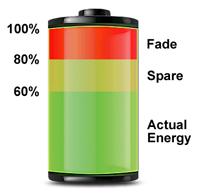How to Verify Sufficient Battery Capacity
Know how to maintain a battery fleet and eliminate the risk of unexpected downtime.
A battery performs well when new but the capacity soon begins to fade with use and time. To assure reliable service during the life span of the battery, design engineers oversize the pack to include some spare capacity. This is similar to carrying extra fuel in an airplane to enable a waiting pattern or attempt a second landing approach when so required.
New batteries operate (should operate) at a capacity of 100 percent; replacement occurs when the packs fade to about 80 percent. All batteries must include a secure level of spare capacity to cover worst-case scenarios.
In addition to normal capacity fade, cold temperature lowers the capacity, especially Li-ion. The capacity loss of a Li-ion Energy Cell is about 17 percent at 0°C (32°F), 34 percent at –10°C (14°F) and 47 percent at –20°C (–4°F). Power Cells perform better at cold temperature with lower cold-related capacity losses than Energy Cells.
Lack of spare capacity is a common cause of system failures. This commonly happens during heavier than normal traffic or in an emergency. During routine operations, marginal batteries can hide comfortably among their peers, but they will fail when put to the test. A battery maintenance program as part of quality control assures that all batteries in the fleet are within the required performance range.
Figure 1 illustrates the breakdown of a battery that includes capacity fade and spare capacity. Adding 20 percent for fade and 20 percent for spare as a safety net leaves only 60 percent for the actual capacity. Such a generous allowance may not be practical in all cases.
| Figure 1: Calculating spare battery capacity. Spare capacity should be calculated for a worst-case scenario. The allowable capacity range is 80-100%; a spare capacity of 20 percent is recommended for critical use. Allow more capacity reserve when operating at cold temperature. |
To verify sufficient spare capacity in a battery fleet, identify batteries that are close to retirement and spot-check their capacities after a busy day with a battery analyzer. The Cadex analyzer provides this function on the “Prime” program in that it applies a discharge before charge. The first reading on the display reflects the spare capacity and the second represents the full capacity after a charge.
If packs with fringe capacity levels come back from a full-day shift with less than 10 percent of spare capacity, raise the pass/fail target capacity from 80 to 85 percent to gain five extra points. If, on the other hand, these old-timers come back with 30 percent before charging, keep them longer by lowering the target capacity to, say, 70 percent. Knowing the energy needs for each application during a typical shift increases battery transparency. This improves reliability and creates a sweet spot between risk management and economics.
While most batteries are replaced when the capacity fades to 80 percent, scanners in some warehouses can be kept longer because they may not require all available capacity during an 8-hour shift. If this is the case, the target capacity can safely be set to 70 percent while maintaining ample spare capacity. A starter battery in a vehicle still cranks the motor with a capacity of 40 percent. The discharge is short and the battery recharges right away. Allowing the capacity to drop much further might prevent the battery from turning the engine on a cold morning, stranding the driver.



